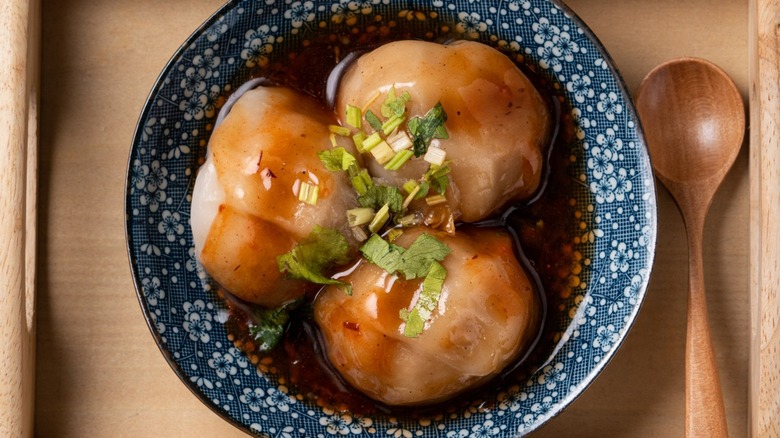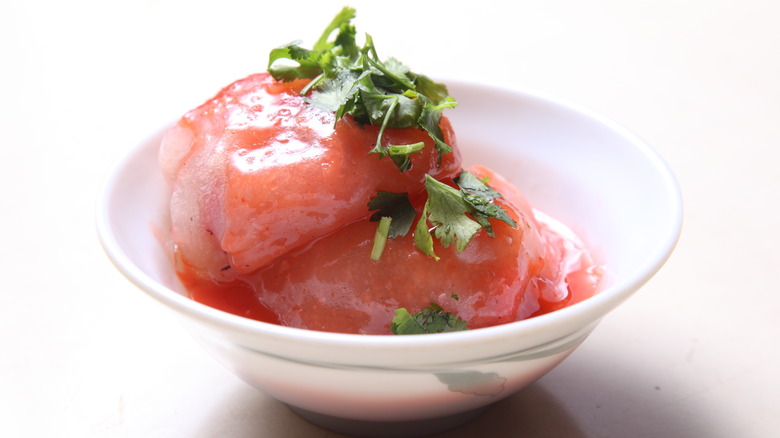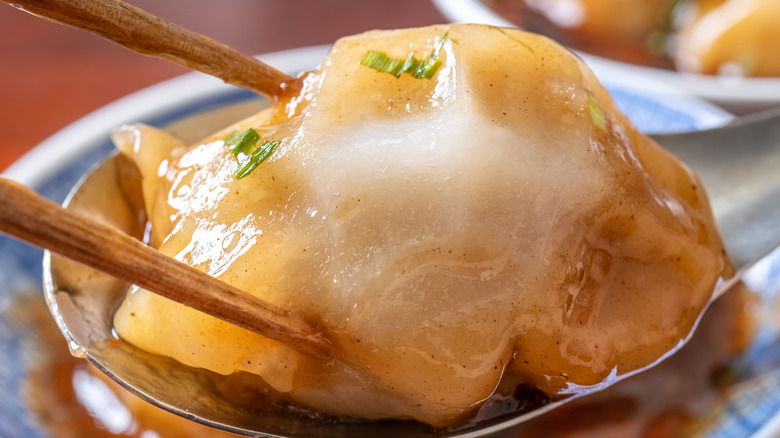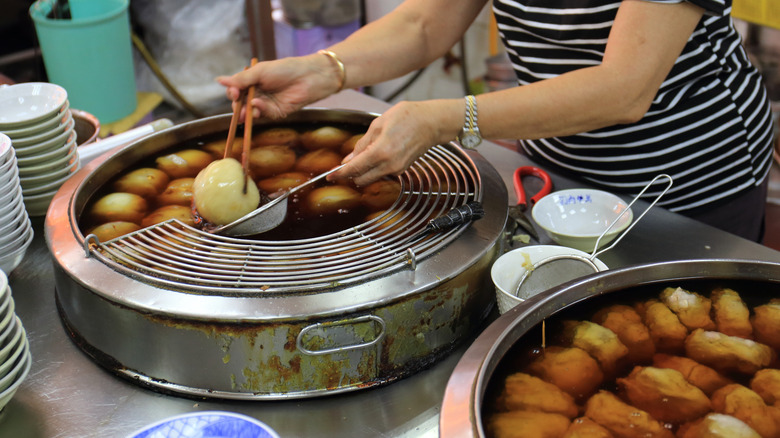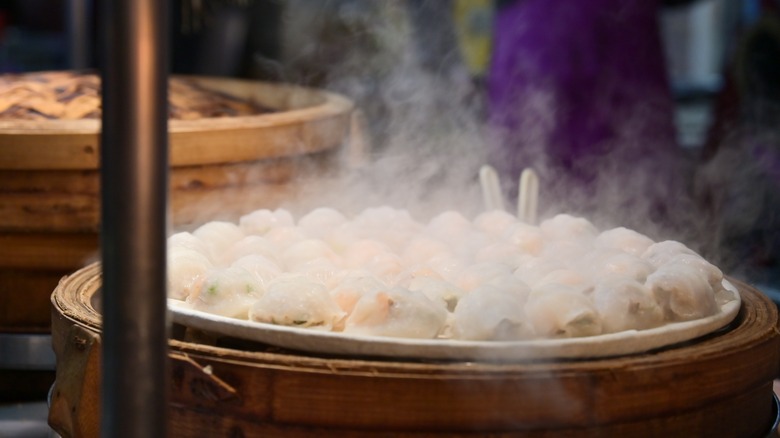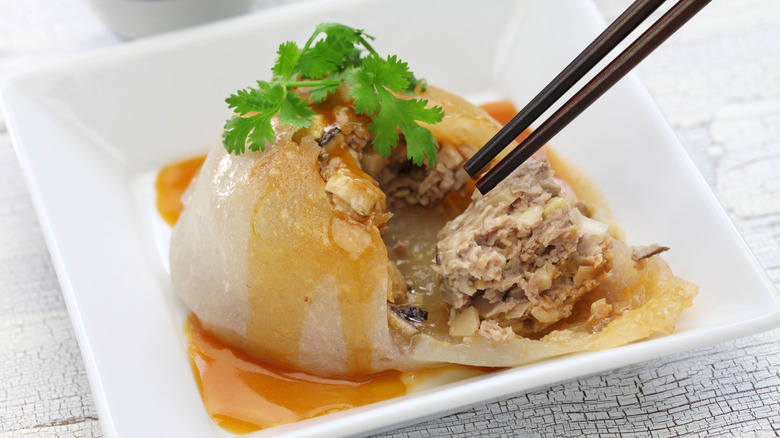Bawan Is The Taiwanese Meatball That Looks Like A Big Piece Of Boba
Dumplings are a comfort food enjoyed worldwide in many diverse forms and flavors depending on where your passport takes you. Because of its range, the dumpling has cemented itself as a culinary staple across cultures. If Taiwan is where your travels take you, you'll get to chow down on a century-old dumpling variant at the night markets of Changhua known as bawan. This Asian street food's name translates to "meatball" because the dough encases a ball of pork mixed with other ingredients, and each one is made to be the size of a fist to hold all the filling. What sets it apart from a typical dumpling, however, is its chewy, boba-like texture and translucent appearance, which led to the dish being dubbed "crystal dumplings" by westerners.
Even though this gelatinous meatball is unique in its own category, there are two main regional variations that can be found on the island — Northern and Southern style. Northern-style bawan is steamed before being deep-fried and covered in a sweet soy sauce-based sauce, which is often cross-sectioned in the middle before serving. In southern Taiwan, bawan is cooked as a steamed delicacy and doused in a sweet chili sauce made from rice milk, and some towns are known for adding shrimp or pan-frying the dumplings. The dough requires a few specific ingredients to get the consistency just right. Each morsel is packed with an array of umami-tasting ingredients, which all come together to create a one-of-a-kind blend of flavors and textures.
The history of bawan began with a deity
Before wheat flour became widely used in Taiwan in the 1950s, the country relied on cooking sweet potatoes and rice to bulk up their meals. Sweet potatoes grew in abundance in the island's climate, were cheap, and could feed more mouths than rice alone. Both were important major crops around the time bawan was first created. The dish's origin is described in a local legend that dates back to 1898 when the Jhuoshuei River flooded the land so badly that all the firewood became ruined and made cooking impossible. In the story, a spirit medium named Fan Wan-chu becomes possessed by a deity and is compelled to jot down the recipe as a way to get more meals to those affected by the disaster.
After discovering how to turn the sweet potato starch into a dumpling casing and steaming it, Wan-chu realized that another cheap and commonly used resource he could throw into his god-given meal was bamboo. After putting the two together, bawan successfully fed the masses and has gone through a few changes since those days. Pork wasn't a part of the earliest recipes since this dish was created using the island's abundant resources, but became the norm as it became the country's staple meat. Today, bawan is a widely celebrated, culturally significant meal eaten in the busy streets of Taiwan and in traditional restaurants alike. It's one legendary dish, quite literally.
Traditional bawan ingredients and recipe variations
Street food vendors will prepare bawan a little differently from region to region, but the dough is traditionally made with rice flour, water, and sweet potato flour. Sweet potato crops have always thrived well on the island, making this specific ingredient an easy one for locals to come by. However, most modern recipes will combine the potato starch with tapioca starch, as this method creates a softer, less gluey dough consistency. After the texture starts to resemble that of boba tea bubbles, the pork tucked inside is mixed with finely diced bamboo shoots and shiitake mushrooms. Seasoning bawan's pork filling isn't a complicated process, and includes only a few basic ingredients like white pepper, soy sauce, and sugar.
The sauce that drenches this meatball-dumpling crossover is a crucial part of this Taiwanese dish, turning it into a savory soup. Bawan shops may use black bean sauce, ketchup, green onions, garlic, or five spice seasoning, and some will even infuse it with licorice for a rich flavor boost. Cutting the bawan dough open and letting the filling pour out into the surrounding sauce is how it's meant to be enjoyed, topped off with a sprinkle of fresh cilantro to garnish.
How Tawainese meatballs are made
The first step to making bawan is to prepare the filling. While ground pork tenderloin is the easy choice, it's recommended to grind your own meat, when possible. This allows chefs to adjust the amount of fat going into the mixture and is the fresher option. How well the filling gets mixed is up to personal preference, whether that be juicy pork chunks or a matted, thoroughly mixed ball of ingredients. After the shiitake mushrooms are sauteed and added to the filling, everything is fried and set aside while the dough is made.
When it comes to dough, most people would conjure up an image of kneading or folding up a flexible base to start making bread or your average dumplings. Bawan, however, aren't your average dumplings. The absence of gluten means the dough won't retain any sort of structure. So instead of a moldable dough, you're left with a sticky white paste after the rice flour has dissolved into the water and has cooked until slightly thickened. It's a tricky technique to master, but all the best bawan stalls and restaurants in Taiwan have got it down to an art form. To form them, small bowls are oiled generously and filled with dough, followed by the filling, and covered fully with more dough before they're placed in a steamer for 10 minutes. After the seasoned chili sauce is done simmering, it's poured on top, drowning the now-translucent bawan in mouthwatering flavors.
Taiwan enjoys bawan differently by region
You'll find that, under the umbrella of Northern and Southern bawan styles, there exists even more diverse recipe variations throughout Taiwan that make it such a versatile food. Most recipes will still feature the authentic staple ingredients of sweet potato or tapioca starch, bamboo shoots, and mushrooms. However, there are also stalls and restaurants that are known for their unique culinary takes on either the dough, flavors, or extra ingredients added. The island's oldest city of Tainen is a perfect example of this, as it's common in this coastal region to find bawan dumplings that include chunks of fresh shrimp mixed into the pork. Depending on what area your nose or palette leads you to, those exploring Taiwan might notice locals eating it differently. Some chow down on the outer layer of dough first, leaving the filling to soak up the sauce and topping it with a splash of bone broth to finish it off.
Street vendors in the Quishan district will pan-fry their bawan, an equally mouthwatering process that turns dumplings a crispy, golden-brown color and adds a boost of flavor. Hsinchu shops will infuse them with red yeast to increase the dumplings' overall sweetness before deep-frying and coating them in a tasty chile sauce. No matter if it's made chunky, crispy, flat, fist-sized, pale, pink, dotted, or drowned in condiments, bawan takes on many shapes, sizes, and flavors while still maintaining its base traditions.
Where to eat bawan in the U.S.
In Taiwan, bawan is usually enjoyed as a savory street food snack eaten by the pair for the affordable equivalent of less than $2 USD. Because this is a widely popular traditional dish throughout the country, there are many local restaurants that either specialize in their own stylized version or feature it on the menu. Some have even been around for as long as 50 years, such as Changhua's famous Da Zhu Meatballs, serving up soft and chewy bawan dumplings, each dotted with its signature red dot. Another highly regarded eatery located in Tainan is Shian Jeng Shrimp Meatballs, which received The Michelin Guide's prestigious rating of Bib Gourmand for its well-priced gourmet bawan.
As for finding a soupy bowl of bawan in the United States, you'd be lucky to find Taiwanese restaurants serving them outside of big cities like New York and a few authentic locations scattered across California. If your quest for the crystal dumpling doesn't prove successful, you could always try your luck at Asian grocery stores like H-Mart or local Taiwanese markets to find some variation of them. But without using your passport to take you directly to the real deal, you'd honestly have more luck finding the ingredients separately and making these chewy meatballs at home. If you're up for the challenge, the best part is that you have the freedom to adjust the dish's sweet and spicy levels according to your taste.
